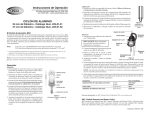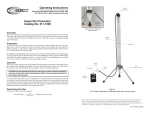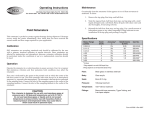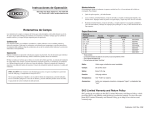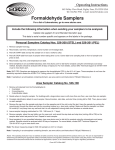Download IOM Personal Sampler 225-70A Operating Instructions 37372 PDF
Transcript
Operating Instructions 863 Valley View Road, Eighty Four, PA 15330 USA Tel: 724-941-9701 Fax: 724-941-1369 e-mail: [email protected] IOM Personal Samplers Stainless steel IOM Conductive plastic IOM Description The patented* IOM Sampler is a sampling head that houses a reusable two-part filter cassette with specified 25-mm filter for the collection of inhalable airborne particles. The filter and cassette assembly are pre and post-weighed as a single unit for gravimetric analysis. The IOM Sampler and cassette is available in conductive plastic or stainless steel. The stainless steel model is ideal for sampling vapor-phase isocyanates followed by chemical analysis. The IOM Sampler meets the following U.S. and international standards: • • • • • • ACGIH sampling criteria for inhalable particulate mass NIOSH Method 5700 for formaldehyde on dust Australian standard for inhalable particulate Preferred sampler for HSE Method MDHS 14/3 Complies with MDHS 25/3 for organic isocyanates (with stainless steel model) Complies with MDHS 6 for lead (with accessory single-hole head) The sampler is supplied with a cassette cover and cassette transport clip to prevent contamination during transport. * U.S. Patent No. 4,675,034 Performance Profile Flow Rate: 50% Cut-point: Material: Max. Temperature for Autoclaving: Filters: Weight: (plastic model with cassette) Dimensions: 2 L/min (personal sampling) 100 μm at 2 L/min inhalable fraction Molded autoclavable conductive plastic or stainless steel Plastic IOM: 104 F (40 C) Stainless steel IOM: 212 F (100 C) 25-mm membrane or fibrous filter < 2 oz (55 gm) 3.3 x 1.1 in (8.5 x 2.8 cm) Preparation Guidelines Handling Wear powder-free gloves when handling cassettes and use forceps when working with filters to prevent the transfer of moisture, dust, or other contaminants onto the sampling media. Housing body Cover Collar clip Cassette Cassette bottom Front top Filter O-ring C plate O-ring A O-ring B Outlet Figure 1. Conductive plastic IOM Sampler and cassette - Cat. No. 225-70A Housing body Cover Front plate Cassette top O-ring A O-ring B Filter Dust cap Collar clip Cassette bottom Outlet Figure 2. Stainless steel IOM Sampler and cassette - Cat. No. 225-76A Dust cap Caution: Wear powder-free gloves when handling cassettes and use forceps when working with filters. 2 O-ring Placement O-ring A O-ring B Proper O-ring placement in IOM front plate, plastic and stainless steel models O-ring C Proper O-ring placement in housing body, plastic model only Figure 2A. O-ring placement Cleaning Sampler 1. Disassemble the IOM Sampler (Figures 1, 2, and 2A). 2. Place parts in an ultrasonic cleaner with water and a wetting agent such as a mild soap. IOM components may also be cleaned with a solvent such as isopropyl alcohol. O-rings should be cleaned separately using water only. Caution: Do not use CFC-based substances to clean the plastic IOM. Do not use solvents on O-rings. Warning: When using solvents, protect against splashes to the eye, vapor inhalation, and vapor ignition. 3. Clean the components using a clean lint-free paper, cloth, or soft brush. Allow components to dry completely. Note: IOM samplers and cassettes may be autoclaved. See Performance Profile on page 2 for maximum temperatures. Loading a Filter into the IOM Cassette 1. Use gentle pressure to separate the two halves of the cassette (Figure 3). 2. Place a filter into the cassette bottom (on the support grid). Snap the cassette top into the cassette bottom, ensuring a tight fit. Cassette top Filter Cassette bottom Figure 3. Exploded cassette 3 Calibration Hinged bracket Calibration Adapter Setup (Figure 4) 1. Push an IOM Sampler loaded with a representative cassette and filter through the hinged bracket and place inlet against the foam ring. 2. Clamp IOM in place with plastic clamping screw until foam ring compresses by 1 mm. Ensure IOM inlet is centered. 3. Screw supplied hose barb into threaded hole in calibration adapter inlet. 4. Use a length of flexible tubing to connect hose barb to calibrator outlet. 5. Remove sampler dust cap from outlet. Connect IOM outlet to the inlet of a sample pump. Plastic clamping screw Foam ring Insert IOM here, inlet side down Adapter inlet Hose barb Figure 4. IOM Calibration Adapter Calibrating Pump Flow Rate Calibrate pump flow rate using the IOM Calibration Adapter accessory and an IOM sampler with a representative loaded cassette installed in line. 1. Insert IOM with loaded filter cassette into the calibration adapter (see Calibration Adapter Setup above). 2. Adjust pump flow rate to 2 L/min. See calibrator and sample pump operating instructions for additional information. 3. Disconnect IOM from pump and calibrator and remove representative cassette. Set aside for flow rate verification after sampling. Filter and Cassette Preparation – Pre-sampling General Weighing Guidelines • Plastic cassette with filter should be equilibrated overnight in a balance room under controlled humidity conditions and weighed. Maintain a stable humidity level in the balance room. Stainless steel cassette with filter may be desiccated. • Pre and post-weigh filter and cassette as a single unit. Before pre and postweighing, wipe the external surface with a clean lint-free paper, cloth, or soft brush. • Field blanks can be used to correct weights when using plastic cassettes at low filter loadings. See Sample Blanks on page 7. • The IOM cassette assembled with filter or the filter alone should be weighed on a five-figure balance. Allow the cassette three and a half minutes to stabilize before taking a reading. The same balance should be used for both pre and post-weighing procedures. 4 Pre-weighing for Gravimetric Sampling 1. Equilibrate cassette and filter as indicated in General Weighing Guidelines above. 2. Wipe the external surface of a loaded IOM cassette with a clean lint-free paper, cloth, or soft brush. 3. Pre-weigh the IOM cassette loaded with a filter as a single unit on a five-figure balance (Figure 5). 4. Note the result and reference it with a letter or number to the cassette or the complete IOM Sampler. Note: The cassette cover (Figure 6) can be included in pre and post-weighing as part of the complete cassette if required, but must be referenced to the cassette used. Figure 5. Weigh cassette with filter on a five-figure balance. Loading Filter into Cassette for Chemical Sampling (Use the stainless steel IOM Sampler and cassette for this application.) 1. Select appropriate coated filter for the target compound. 2. Use gentle pressure to separate the two halves of the stainless steel cassette (Figure 3 on page 3). 3. In a clean environment, wearing powder-free gloves and using forceps, place filter in stainless steel cassette bottom (on the support grid). Snap the stainless steel cassette top into the cassette bottom, ensuring a tight fit. Transporting Loaded Cassettes If not ready to sample immediately or if transporting the pre-weighed loaded cassette to a sampling location, place the cassette with cover into the transport clip. Ensure that the cassette cover is in place. An alternative is to insert the cassette into an IOM body and place the cover on the cassette for transport (Figure 6). Cover Front plate Cassette assembled with filter Figure 6. Load pre-weighed cassette into a transport clip or an IOM body; include cover. 5 Housing body Sampling Caution: Wear powder-free gloves when handling cassettes. 1. Remove a loaded cassette from its transport clip and remove the cassette cover. Ensure the O-rings are fitted correctly inside the sampler housing body. Insert the cassette into the clean IOM Sampler body. Screw on the front plate tightly to provide a good seal Figure 7. Insert loaded cassette in (Figure 7). sampler body and screw on front plate. 2. Clip onto a worker’s clothing in the breathing zone (Figure 8). 3. Remove sampler dust cap from outlet. Using tubing, connect outlet of the IOM Sampler to the inlet of a sample pump calibrated to 2 L/min (Figure 8). 4. Sample for the time specified in the method. 5. After sampling, remove the cassette from the sampler body, place the cover on the cassette, and wipe the external surface of the cassette with a clean lint-free paper, cloth, or soft brush. Place cassette with cover into the transport clip (Figure 9). See Transporting Samples to a Laboratory on page 7 if postweighing is not to be performed on the premises. Note: If inhalable samples were collected to determine exposure to formaldehyde on dust using NIOSH Method 5700, place the cassette cover on the cassette and load it into the transport clip (Figure 9). Send cassette in clip, a blank, and all other pertinent sampling information to a laboratory for analysis. Figure 8. IOM Sampler and pump on worker 6 Transporting Samples to a Laboratory For gravimetric samples: Place cassette cover on cassette immediately following sampling and insert into a transport clip (Figure 9). Place unit into a sterile plastic bag. Package in a padded envelope and send to a laboratory for analysis. Include pertinent sampling information and blanks. If post-weighing on the premises, see Analysis, Post-weighing for Gravimetric Analysis below. Figure 9. Load IOM cassette into transport clip. For chemical samples: 1. Wearing gloves, unscrew the IOM front plate. 2. Remove the stainless steel cassette. 3. Choose from the following options: a. Immediately place entire cassette/filter assembly into a large vial filled with method-specified desorbing solution and cap the vial or, b. Immediately remove cassette top and use forceps to remove filter. Place filter in a vial filled with method-specified desorbing solution and cap the vial. 4. Package securely to prevent leakage and breakage, include pertinent sampling information and blanks, and send to a laboratory for analysis. Sample Blanks Load and handle the blank IOM Sampler in the same manner as the IOM used for sampling. Do not pull air through the blank. Send the blank with the samples to a laboratory. Analysis Post-weighing for Gravimetric Analysis Caution: Wear powder-free gloves when handling cassettes and use forceps when working with filters. 1. If using a plastic cassette, equilibrate cassette and filter for a reasonable time based on humidity conditions. 2. Remove the cassette from the transport clip before weighing. The cassette cover can remain on if it was used during pre-weighing. 3. Weigh the entire cassette. Compare the pre and post weights. The difference is the amount of inhalable particles collected. The IOM cassette can be cleaned, reloaded with a fresh filter, and reused. See Cleaning Sampler on page 3. Chemical Analysis Follow method instructions for sample preparation and analysis. 7 References Mark, D. and Vincent, J. H., “A New Personal Sampler for Airborne Total Dust in Workplaces,” Ann. Occup. Hyg. Vol. 30, 1986, pp. 89-102 ACGIH Technical Committee on Air Sampling Procedures: Particle Size-selective Sampling in the Workplace, ACGIH, Cincinnati, Ohio, 1984 Ordering Information The IOM requires a 25-mm filter; see below. Description IOM Sampler and cassette, in conductive plastic, with transport clip and cover IOM Sampler and cassette, in stainless steel, with transport clip and cover IOM Sampler, in conductive plastic, with stainless steel cassette, transport clip, and cover Cat. No. 225-70A 225-76A 225-79A Accessories Cassette assembly, in conductive plastic, with transport clip and cover Cassette assembly, in stainless steel, with transport clip and cover Transport Clip and Cover Calibration Adapter Single Hole Lead Head, for sampling lead according to MDHS 6 225-71A 225-75A 225-72A 391-01 225-52 25-mm Filters for IOM, each sample requires its own filter PVC, 5.0 μm, pk/100 Glass Fiber, 1.0 μm, pk/500 MCE, 0.8 μm, pk/100 Polycarbonate, 0.8 μm, pk/100 Gelatin, pk/50 225-8-04 225-702 225-1930 225-1601 225-9551 SKC Limited Warranty and Return Policy SKC products are subject to the SKC Limited Warranty and Return Policy, which provides SKC’s sole liability and the buyer’s exclusive remedy. To view the complete SKC Limited Warranty and Return Policy, go to http://www.skcinc.com/ warranty.asp. www.skcinc.com Form #37372 Rev 1006 8












